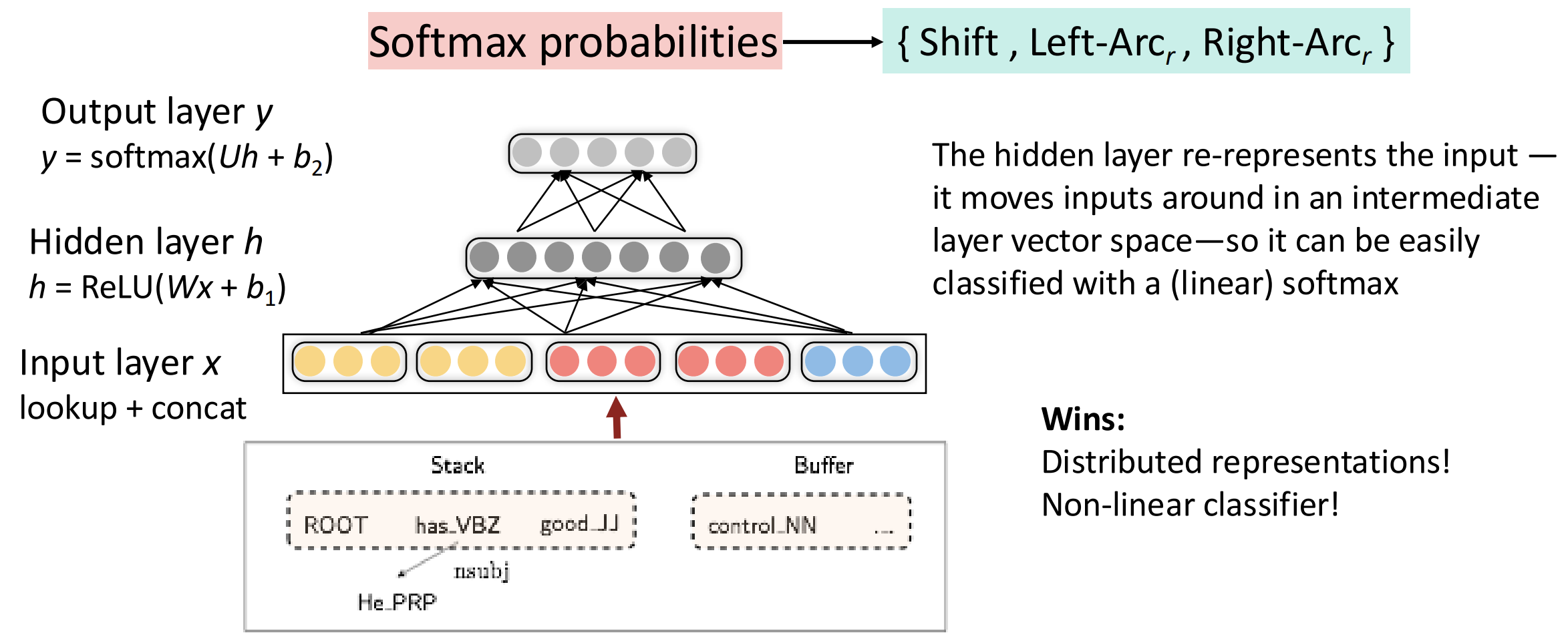句子的语言结构
观点1:Phrase Structure与CFG (Context-free Grammar)
将一个句子表示为一棵树,树的结构反应短语与短语的嵌套结构
一个CFG的生成规则示例如下:
NounPrase -> Det (Adj)* N
NounPrase -> NounPrase PrepositionPrase
PrepositionPrase -> Prep NounPrase
Det -> {a, the, ...}
Adj -> {large, small, ...}
...观点2:Dependency structure (更常用)
将一个句子表示为一棵树,树的结构反应单词与单词之间的依赖关系

Dependency structure允许non-projective parsing (及存在交叉依赖,如图中的红线)。但是使用CFG构建的句子结构不可能出现这类情况。
Dependency Parsing
给定一个句子,有几种方式可以将其解析为Dependency structure
transition-based parsing
遍历句子中的词,过程中维护一个栈,每次选择以下三种操作 (Transition) 之一,直至完全遍历且栈中只剩下ROOT一个元素。
- SHIFT:将Buffer中最左侧的词入栈
- LEFT-ARC:将栈顶左侧的词标记为栈顶的dependency,并将该词移除
- RIGHT-ARC:将栈顶的元素标记为其左侧元素的dependency,并将该词移除

| Stack | Buffer | New dependency | Transition |
|---|---|---|---|
| [ROOT] | [I, presented, my, findings, at, the, NLP, conference] | Initial Config | |
| [ROOT, I] | [presented, my, findings, at, the, NLP, conference] | SHIFT | |
| [ROOT, I, presented] | [my, findings, at, the, NLP, conference] | SHIFT | |
| [ROOT, presented] | [my, findings, at, the, NLP, conference] | presented → I | LEFT-ARC |
| [ROOT, presented, my] | [findings, at, the, NLP, conference] | SHIFT | |
| [ROOT, presented, my, findings] | [at, the, NLP, conference] | SHIFT | |
| [ROOT, presented, findings] | [at, the, NLP, conference] | findings → my | LEFT-ARC |
| [ROOT, presented] | [at, the, NLP, conference] | presented → findings | RIGHT-ARC |
| [ROOT, presented, at] | [the, NLP, conference] | SHIFT | |
| [ROOT, presented, at, the] | [NLP, conference] | SHIFT | |
| [ROOT, presented, at, the, NLP] | [conference] | SHIFT | |
| [ROOT, presented, at, the, NLP, conference] | [] | SHIFT | |
| [ROOT, presented, at, the, conference] | [] | conference → NLP | LEFT-ARC |
| [ROOT, presented, at, conference] | [] | conference → the | LEFT-ARC |
| [ROOT, presented, conference] | [] | conference → at | LEFT-ARC |
| [ROOT, presented] | [] | presented → conference | RIGHT-ARC |
| [ROOT] | [] | ROOT → presented | RIGHT-ARC |
可以训练一个神经网络,在每一步作出正确的Transition决策:

graph-based parsing
对于句子中的每一个词,计算其是其他所有词的依赖的可能性。 之后使用诸如最小生成树的方式建树。